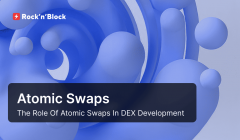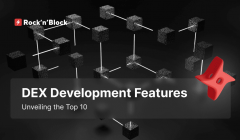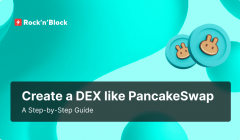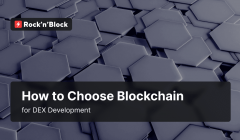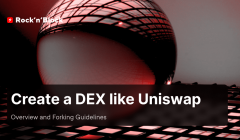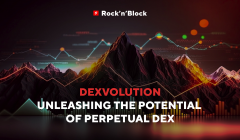Create a DEX Like GMX: Perpetual Exchange Guide
03 May 2024Perpetual decentralized exchanges development has transformed the world of decentralized finance. At its leading edge is GMX, a top-tier perpetual DEX known for its cutting-edge features and robust architecture.
The rise of perpetual DEXs presents an exciting opportunity for those aiming to create a DEX like GMX. You can fork a DEX similar to GMX to leverage its success and introduce unique features.
Explore how to use this momentum to create a DEX that stands out in the competing DeFi landscape!
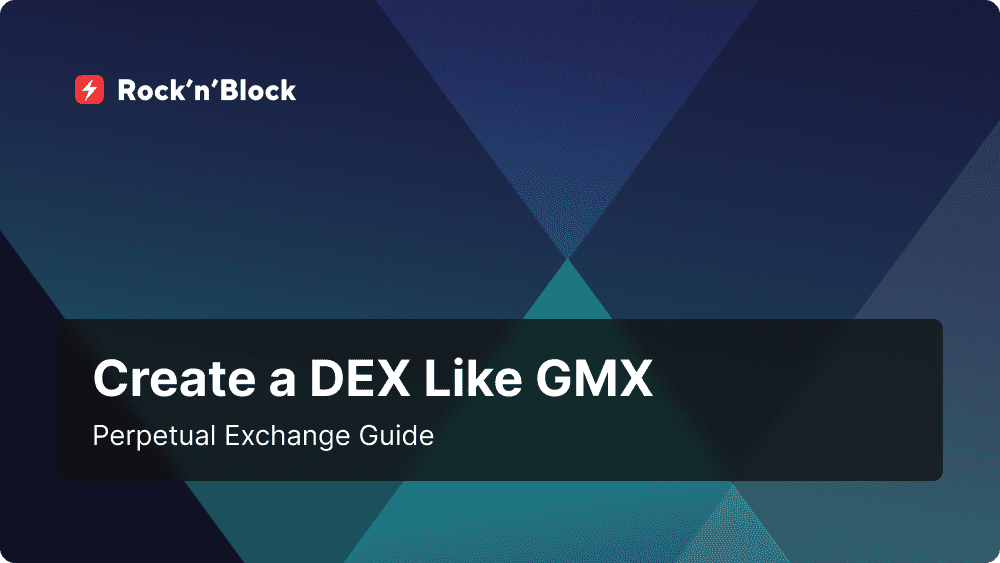
Table of Contents:
-
GMX: A Revolutionary Perpetual DEX
-
Understanding Perpetual DEX Development
-
GMX Features Overview
-
The Process of Forking GMX
-
Challenges of Building a Perpetual DEX
-
Conclusion
⭐️ GMX: A Revolutionary Perpetual DEX
Decentralized exchanges (DEXs) have been a revolutionary force in the financial industry. GMX is a pioneering example, redefining the landscape with its innovative perpetual nature. Let’s delve into the intricacies of GMX and explore why it's the pinnacle of next-generation DEXs.
Overview of GMX and Its Architecture
GMX launched its platform in September 2021 on Arbitrum, a layer 2 network. In 2022, the platform expanded its operations to Avalanche. Avalanche, renowned for its high-speed transactions, operates as a layer 1 solution compatible with the Ethereum Virtual Machine (EVM), further broadening GMX's accessibility and performance capabilities.
According to GMX’s data, by 16 February, 2024, its Total Trading Volume is $176B with total users amount more than 480,000.
GMX functions as a decentralized spot and perpetual exchange, offering low swap fees and facilitating trades with minimal price impact. The platform features unique multi-asset pools that allow liquidity providers to earn fees from market making, swap fees, and leverage trading.
GMX serves as an exemplary model for creating a DEX due to its robust infrastructure and comprehensive feature set. GMX uses blockchain technology and smart contracts to enable transparent and secure transactions, giving users complete control over their assets without the need for intermediaries.
Before delving into the unique features of GMX and the process of creating a DEX like it, it's essential to grasp the perpetual nature inherent in such decentralized exchanges.
💭 Understanding Perpetual DEX Development
The concept of perpetual DEX development represents a significant difference from conventional trading mechanisms. Unlike traditional exchanges with futures contracts that have fixed time frames for closure, perpetual DEX development's core feature is the introduction of perpetual swaps. Perpetual swaps are a type of derivative contract with no expiration date. Traders can take long and short positions, hedge their exposure, and maximize profit potential in volatile markets.
For those looking to create a DEX, integrating perpetual functionality similar to GMX can unlock a myriad of benefits. Perpetual DEX platforms streamline the trading process and enhance liquidity by eliminating the need to constantly roll over contracts or adjust positions. This perpetual liquidity not only fosters a more dynamic marketplace but also minimizes slippage and ensures fair pricing for all participants.
Benefits of Perpetual DEX Development
1. Continuous Trading: Perpetual DEX development enables traders to trade without restrictions, offering uninterrupted access to the market 24/7.
2. Leverage and Margin Trading: Perpetual DEXs often support leverage and margin trading, allowing traders to amplify their positions and potentially increase profits.
3. Automated Liquidation Mechanisms: Perpetual DEXs implement automated liquidation mechanisms to mitigate the risk associated with leveraged trading. These mechanisms prevent account balances from falling below acceptable thresholds, reducing the likelihood of cascading liquidations.
4. Access to Derivative Trading: Perpetual swaps enable derivative trading and speculation on price movement.
5. Funding Mechanism: Perpetual DEXs utilize a funding mechanism to maintain price alignment with underlying assets.
Learn more about the perpetual DEX development in our article!
Perpetual DEX development represents a significant advancement in decentralized trading, offering traders unprecedented flexibility, efficiency, and accessibility. If you're looking to create a decentralized exchange, perpetual DEXs stand as a beacon of innovation and opportunity in the DeFi ecosystem.
⚙️ GMX Features Overview
With the fast growing world of decentralized finance, creating a DEX requires innovation and differentiation. Among many options available, GMX stands out as a beacon of ingenuity, offering a number of unique features that set it apart from its competitors. Let's explore these distinctive features and understand how they elevate GMX in the realm of DEX development.
Leverage Trading
GMX supports both swaps and leverage trading. Let’s explore the key leverage trading processes and functionality of GMX V2:
-
Position Opening
GMX DEX simplifies position opening with customizable options tailored to market preferences and risk management. Users can choose between "Long" or "Short" positions depending on their market outlook.
-
Long Position: Profit from price increases.
-
Short Position: Profit from price decreases.
-
Collateral Selection
Multiple types of collateral may be available for users’ selected market, for example (based on ETH-USDC market):
-
Long ETH with ETH as collateral: Combined exposure of long position and collateral.
-
Long ETH with USDC as collateral: Simplified longing and shorting transitions.
-
Short ETH with ETH as collateral: Ideal for delta neutral strategies.
-
Short ETH with USDC as collateral: Flexible position management.
-
Max Allowed Leverage
The maximum allowed leverage is the highest level of borrowed funds a trader can utilize to open or increase a position within a pool, which may decrease as total open interest rises to safeguard against price impact manipulation.
-
Dynamic Leverage Limits: The maximum allowed leverage of a pool will decrease as the total open interest of the pool increases. This adjustment helps guard against manipulation of price impact through high leverage positions.
-
Effect on Opening/Increasing Positions: The adjusted maximum leverage will affect the opening or increasing of positions. Traders will be limited by the maximum leverage allowed by the pool based on its total open interest.
-
Effect on Closing/Decreasing Positions: While closing or decreasing positions, if the maximum allowed leverage is exceeded, the order can still be executed. However, the collateral within the position would not be reduced. This ensures that leverage limits are enforced effectively.
-
Liquidations
Liquidation refers to the automatic closure of a position when its losses exceed collateral value, triggered by the token's price crossing a predefined threshold, safeguarding against further losses
-
Liquidation Price Calculation: The liquidation price is determined as the price at which the (collateral - losses - fees) is less than 1% of the position's size. This price is calculated based on the oracle price with a capped negative price impact.
-
Automatic Closure: If the token's price crosses the liquidation price, the position will be automatically closed to prevent further losses.
-
Change Over Time: Liquidation price can change over time due to borrowing and funding fees, particularly if leverage is more than 10x and the position is open for an extended period. Monitoring the liquidation price is crucial to manage risk effectively.
-
Collateral Management: Depositing additional collateral can help improve the liquidation price and reduce the risk of liquidation. This can be done through the platform's interface.
-
Return of Remaining Collateral: When a position is liquidated, any remaining collateral after deducting losses and fees will be returned to the trader's account.
Diverse Order Types
Limit Orders
Limit orders on GMX DEX provide traders with the ability to set specific entry or exit points. Once created, these orders can be managed, allowing for adjustments to trigger prices as necessary. Limit orders offer traders a powerful tool for executing trades with precision and flexibility on the GMX DEX platform.
Stop-Loss / Take-Profit Orders
-
Stop-Loss Order: In leverage trading within the crypto market, a stop-loss order is an instruction set by a trader to automatically sell a specific cryptocurrency asset when its price reaches a predetermined level. This level is chosen by the trader as a point where they want to limit their potential losses. By setting a stop-loss order, traders seek to mitigate their risk exposure in case the market moves against their position. If the price of the cryptocurrency reaches or falls below the stop-loss level, the stop-loss order triggers a market sell order, helping the trader exit the position and minimize further losses.
-
Take-Profit Order: In leverage trading within the crypto market, a take-profit order is an instruction set by a trader to automatically sell a specific cryptocurrency asset when its price reaches a predetermined level of profit. This level is chosen by the trader as a point where they want to lock in their gains. By setting a take-profit order, traders aim to capitalize on favorable market movements and ensure they don't miss out on potential profits. If the price of the cryptocurrency reaches or surpasses the take-profit level, the take-profit order triggers a market sell order, allowing the trader to exit the position and secure their profits.
Market Types and ADL
In GMX V2, there are two types of markets: fully backed markets and synthetic markets.
Fully Backed Markets
Fully backed markets are trading environments in which the open interest, or the total value of all outstanding positions, is constrained to be less than or equal to the total value of assets held in the market's liquidity pool. In these markets, the value of all positions can always be fully covered by the assets in the pool. This ensures that profits and losses incurred by traders can always be settled without risk of insolvency, regardless of market movements.
Synthetic Markets
Synthetic markets are trading environments where the value of outstanding positions may exceed the total value of assets held in the market's liquidity pool. In synthetic markets, traders may be able to take positions that have the potential to generate profits greater than the value of the underlying assets. This can occur when the market is exposed to highly volatile assets or when leverage is utilized. To mitigate the risk of insolvency in synthetic markets, mechanisms such as Auto-Deleveraging (ADL) may be employed to partially or fully close profitable positions when they exceed certain thresholds, ensuring the market remains solvent.
Fees and Rebates Structure
-
Open / Close Fees
Traders on GMX DEX benefit from competitive fees when opening or closing positions, starting as low as 0.05%. Moreover, the platform offers rebates to mitigate high price impacts during periods of market volatility, ensuring a fair and balanced trading environment.
-
Swap Fees
Users can seamlessly exchange assets on GMX DEX with minimal fees, starting from 0.005%. For stablecoin swaps, there are even lower rates beginning at 0.005%.
-
Price Impact and Rebates
GMX equips users with tools to monitor and manage price impacts effectively. Positive impacts translate to more favorable entry and exit prices, while the rebate system helps offset negative impacts during turbulent market conditions, providing traders with greater control over their investments.
-
Funding Fees
Users can stay informed about adaptive funding rates that adjust in real-time based on market dynamics. These rates ensure fairness and transparency, allowing traders to optimize their positions while minimizing costs.
-
Borrowing Fees
Maintain liquidity and incentivize market participation through the borrowing fee system, which adjusts according to pool utilization. This mechanism encourages the continuous addition of liquidity, contributing to a robust trading ecosystem.
-
Execution Fees
GMX DEX prioritizes transparency by providing clear insights into execution fees during trade confirmation. This transparency enables users to make informed decisions and effectively manage their trading costs.
-
One-Click Trading
The one-click trading feature is designed to streamline the trading process. While offering unparalleled convenience, GMX prioritizes user safety by implementing robust security measures to safeguard assets.
Cross-Chain Compatibility
GMX boasts cross-chain compatibility, enabling seamless integration with multiple blockchain networks. This versatility allows GMX to tap into a broader range of assets and liquidity pools, providing users with unparalleled access to diverse trading opportunities.
Decentralized Governance
GMX is committed to decentralization and community empowerment. Through decentralized governance mechanisms, stakeholders have control over platform decision-making processes, from fee adjustments to protocol upgrades. This ensures a truly decentralized and democratic platform.
Trading Dashboards
Trading dashboards are user interfaces within DEXs that serve as the primary interface through which users interact with the platform.
-
Real-time Data
Trading dashboards provide users with live updates on asset prices, order book depth, trade execution status, and other market data.
-
Historical Data
The historical data is essential for traders to identify patterns, develop trading strategies, and make informed decisions based on past performance.
-
Analytics Tools
Trading dashboards often include a variety of analytics tools and technical indicators that allow traders to perform in-depth technical analysis.
Whether you're looking to create a DEX, GMX sets itself apart with its unique decentralized exchange development features and unwavering commitment to decentralization.
🛠️ The Process of Forking GMX
Forking GMX can be a strategic move for founders seeking to leverage existing infrastructure while introducing new features or addressing specific market demands. However, the forking process requires careful consideration and meticulous planning to ensure a successful outcome. In this section, we'll explore the steps involved in creating a DEX like GMX.
1. Research and Analysis
Before diving into the forking process, it's crucial to conduct thorough research and analysis of GMX and its underlying technology. This includes researching the DEX's architecture, smart contracts development, governance mechanisms, and user interface. Understanding these aspects will provide valuable insights into the intricacies of GMX and guide the forking process.
2. Identify Forking Objectives
Define clear objectives for creating a DEX like GMX, outlining the specific features or improvements you intend to introduce. Whether it's optimizing performance, enhancing security, or adding new functionalities, having a clear roadmap will streamline the forking process and ensure alignment with your project goals.
3. Choose Blockchain Platform
The crucial step in the development process is choosing the right blockchain platform for DEX development. GMX operates on Arbitrum, a layer 2 network designed to enhance the scalability and efficiency of Ethereum-based applications. Evaluate the specific requirements and goals of your DEX project development to determine the most suitable variant. Whether you opt for Arbitrum or another blockchain platform, ensure that it aligns with your project's scalability, security, and performance objectives.
4. Set Up Development Environment
Create a development environment conducive to forking GMX, including setting up the necessary tools, libraries, and frameworks.
5. Fork GMX Codebase
Clone the GMX codebase from the repository and fork it into your own project repository. This will serve as the foundation for your forked DEX, allowing you to modify and customize the code according to your project requirements.
6. Customize and Modify
Implement the desired changes and customizations to the GMX codebase based on your forking objectives. This may involve modifying smart contracts, updating user interfaces, integrating additional features, or optimizing performance.
7. Prioritize a User-Friendly Interface
An important step in DEX development is to prioritize a user-friendly interface to enhance the user's trading experience. Invest time and resources into designing an intuitive interface that simplifies navigation, streamlines the trading process, and provides easy access to essential features and information.
8. Testing and Quality Assurance
Thoroughly test the forked DEX to ensure functionality, security, and performance. Conduct thorough security audits, rigorous testing across various scenarios, including different trading pairs, transaction volumes, and network conditions. Address any bugs or issues identified during testing before proceeding to deployment.
9. Deployment and Launch
Deploying the modified version of your DEX marks the final step of the DEX development process. After thorough testing and satisfaction with the results, deploy your smart contracts on the mainnet and integrate the updated frontend. This phase demands meticulous planning and constant monitoring to ensure a successful launch. Implement marketing strategies to attract users and maintain open communication with stakeholders. Prioritize transparency, security, and user experience to build trust and credibility within the decentralized finance community, ensuring the success of your DEX in the competitive marketplace.
10. Maintenance and Updates
Following the DEX launch, establish a robust maintenance and updates protocol to ensure ongoing functionality and optimization. Monitor the platform regularly for technical issues, bugs, or security vulnerabilities, and promptly address them. Stay informed about industry trends and proactively implement updates and improvements to remain competitive.
Creating a DEX like GMX presents an opportunity for founders to create innovative solutions and address specific market needs. By following the steps outlined above and considering important factors such as legal compliance, community engagement, sustainability, differentiation, and security, you can navigate the forking process effectively and successfully create a DEX tailored to your project goals and objectives.
Whether you're looking to create a DEX from scratch or fork an existing platform like GMX, careful planning and execution are essential for achieving success in the decentralized exchange development space.
Explore our related articles:
😵💫 Challenges of Building a Perpetual DEX
Creating a DEX like GMX presents several challenges, primarily due to the inherent complexity of decentralized exchange development. The intricacies involved in smart contract development, order-matching algorithms, liquidity management, and security protocols can pose significant hurdles for inexperienced developers. Moreover, ensuring seamless integration with multiple blockchain networks, optimizing trading performance, and complying with regulatory requirements further add to the complexity.
Successfully navigating these challenges requires a deep understanding of blockchain technology, DeFi protocols, and industry best practices. Utilizing the expertise of experienced blockchain developers can streamline the development process and mitigate potential risks. Experienced developers like Rock’n’Block will bring invaluable insights, technical proficiency, and a proven track record of delivering successful DEX projects, making them essential partners in creating a DEX like GMX.
By collaborating with Rock’n’Block, you can overcome the complexities inherent in DEX development and ensure the successful implementation of your project, as we provide:
-
Solid Expertise in Blockchain Development: Rock'n'Block is a team of experienced blockchain developers with a proven track record of success. We have a deep understanding of blockchain technology, smart contract development, and decentralized finance, which enables us to deliver robust and scalable solutions for DEX development. By choosing Rock'n'Block to create a DEX, you will have access to a team of experts who are passionate about pushing the boundaries of decentralized finance. Our technical expertise and industry knowledge will bring your vision to life.
-
Tailored Solutions for Perpetual DEX: Rock'n'Block provides custom solutions for perpetual DEX development that are tailored to meet your specific requirements and objectives. We work closely with you to optimize performance, enhance security, or integrate advanced features, ensuring that our solution exceeds your expectations. Our approach to the DEX development is comprehensive, covering smart contract development, user interface design, testing, deployment, and ongoing support. We use the latest technologies and best practices to ensure that your perpetual DEX is functional, reliable, user-friendly, and scalable.
Conclusion
The rise of perpetual decentralized exchanges like GMX marks a pivotal moment in the evolution of decentralized finance. With its innovative features and robust architecture, GMX has demonstrated the potential of perpetual DEXs to redefine how users engage with digital assets.
Rock'n'Block is a reliable partner for founders who are looking to create a perpetual DEX. We are always here to turn your decentralized dreams into reality!
Contact us today to learn more about how we can help you build the next-generation decentralized exchange that revolutionizes the world of decentralized finance.
We ❤️ Development
Follow us on social media to receive the hottest blockchain development updates
